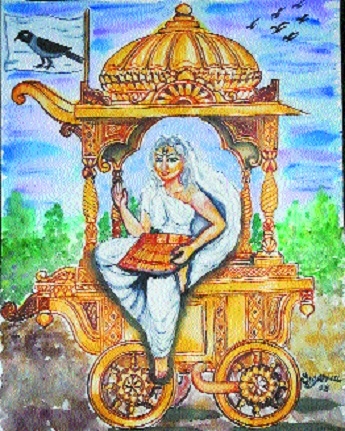Dhumavati - The Grandmother Spirit
| Date :01-Apr-2020 |

By Rajendra Diwe :
DHUMAVATI is the seventh of the ten Mahavidya Goddesses. According to Thodala Tantara Maa Dhumavati is the equivalent of Varaha Avatara. Devi Dhumavati is an old widow and is associated with things considered inauspicious and unattractive. She is always hungry and thirsty who initiates quarrels. In characteristics and nature She is compared with Goddess Alakshmi, Goddess Jyeshta and Goddess Nirriti. All these three Goddesses are embodiment of negative qualities but at the same time worshipped at special timings of the year.
David Kinsley in his book, ‘Tantric visions of the Divine Feminine’ writes, “Dhumavati is ugly, unsteady and angry. She is tall and wears dirty clothes. Her ears are ugly and rough, she has long teeth, and her breasts hang down. She has along noose. She has the form of a widow. She rides in a chariot that has a banner on top decorated with a crow emblem. Her eyes are fearsome, and her hands tremble. In one hand she holds a winnowing basket, and with the other hand she makes the gesture of conferring boons. Her nature is rude. She is always hungry and thirsty and looks unsatisfied.
She likes to create strife, and she is always frightful in appearance”. According to Tamil Brahmin Forum, “What David Kinsley has written is the translation of one of the Dhyana Slokas of Maa Dhumavati depicts her as Ugly to say the least. David Kinsley compares her to the Goddesses Jyeshta and Alakshmi. But there is a major difference in the Maa Dhumavati gives boons to the Upasakas. As per legend mentioned in Pranatoshini Tantra, once Devi Sati to satiate her extreme hunger, swallowed Lord Shiva. Later, on the request of Lord Shiva himself, she disgorged Him. After this incident, Lord Shiva rejected Her and cursed Her to assume the form of a widow.” In Tamil Nadu, Goddess Dhumavati is depicted as an old and ugly widow. She is thin, unhealthy with pale complexion.
Unlike other Mahavidya(s), She is unadorned with jewelry. She wears old, dirty clothes and has disheveled hair. She is portrayed with two hands. In one of her trembling hands, She holds a winnowing basket and makes either boon conferring gesture or knowledge giving gesture with the other hand. The boon conferring gesture and knowledge giving gesture are known as Varada Mudra and Chin Mudra respectively. She rides on a horseless chariot bearing an emblem of a crow.
Goddess Dhumavati’s Sadhana is done to get rid of extreme poverty. She is also worshipped to make body free from all sorts of diseases. In Sanatan Society, Dhumavati is considered as the eldest among the Goddesses, the Grandmother Spirit. She stands behind the other Goddesses as their ancestral guide. As the Grandmother Spirit she is the great teacher who bestows the ultimate lessons of birth and death. She is the knowledge that comes through hard experience, in which our immature and youthful desires and fantasies are put to rest. Dasha Mahavidya, published by Geeta Press Gorakhpur mentions, “Dhuma means ‘smoke.’ Dhumavati is ‘one who is composed of smoke.’ Her nature is not illumination but obscuration. However, to obscure one thing is to reveal another.
By obscuring or covering all that is known, Dhumavati reveals the depth of the unknown and the unmanifest. Dhumavati obscures what is evident in order to reveal the hidden and the profound. Dhumavati is portrayed as a widow. She is the feminine principle devoid of the masculine principle. She is Shakti without Shiva as a pure potential energy without any will to motivate it. Thus, she contains within herself all potentials and shows the latent energies that dwell within us. To develop these latent energies we must first recognise them. This requires honouring Dhumavati.” According to David Frawley, “Dhumavati shows the feminine principle of negation in all of its aspects. On an outer level she represents poverty, destitution, and suffering, the great misfortunes that we all fear in life. Hence she is said to be crooked, troublesome, and quarrelsome – a witch or a hag.
Yet on an inner level this same negativity causes us to seek a greater fulfillment that cannot be achieved in the limited realms of the manifest creation. After all, only frustration in our outer life causes us to seek the inner reality. Dhumavati is whatever obstructs us in life, but what obstructs us in one area can release a new potential to grow in a different direction. Thus, she is the good fortune that comes to us in the form of misfortune. Dhumavati represents the darkness on the face of the deep, the original chaos and obscurity which underlies creation. She is the darkness of primordial ignorance, Mulavidya, from which this world of illusion has arisen, and which it is seeking to transcend.”
“Dhumavati represents the power of ignorance or that aspect of the creative force which causes the obscuration of the underlying light of consciousness. While Maya is the magic or illusion power of the Lord that makes the one reality appears as many, ignorance is a form of darkness which prevents us from seeing the underlying reality. Dhumavati is the void, wherein all forms have been dissolved and nothing can any longer be differentiated. Yet this void is not mere darkness. It is a self-illumining reality free of the ordinary duality of subject and object. Dhumavati represents the negative powers of life: disappointment, frustration, humiliation, defeat, loss, sorrow and loneliness. Such experiences overpower the ordinary mind, but to the yogi they are special doors of opportunity to contact the reality which transcends desire,” Frawley states.